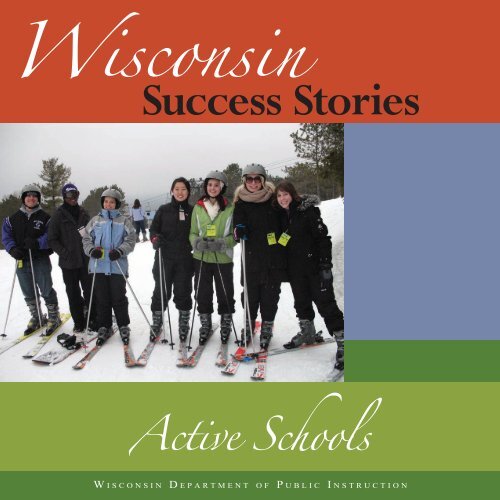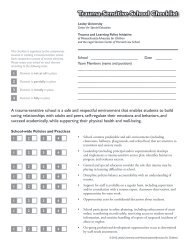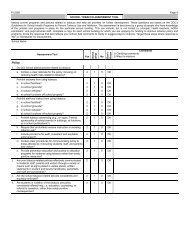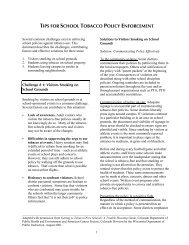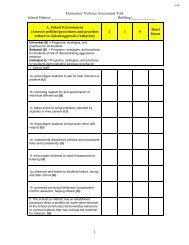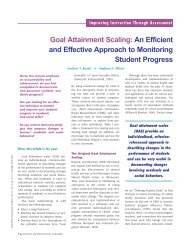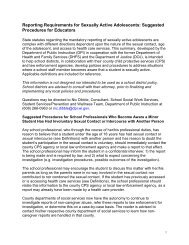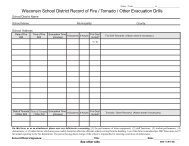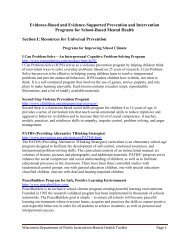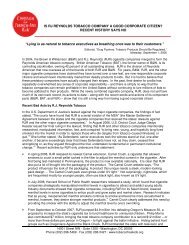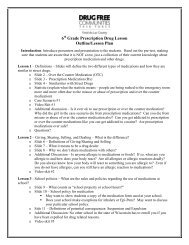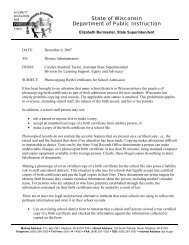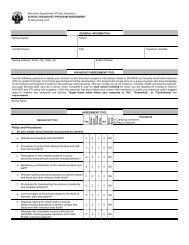Success Stories: Active Schools - Student Services / Prevention and ...
Success Stories: Active Schools - Student Services / Prevention and ...
Success Stories: Active Schools - Student Services / Prevention and ...
- No tags were found...
You also want an ePaper? Increase the reach of your titles
YUMPU automatically turns print PDFs into web optimized ePapers that Google loves.
Wisconsin<strong>Success</strong> <strong>Stories</strong><strong>Active</strong> <strong>Schools</strong>W i s c o n s i n D e p a r t m e n t o f P u b l i c I n s t r u c t i o n
Wisconsin<strong>Success</strong> <strong>Stories</strong><strong>Active</strong> <strong>Schools</strong>Ken WagnerEducation Consultant<strong>Student</strong> <strong>Services</strong>/<strong>Prevention</strong> <strong>and</strong> Wellness TeamTony Evers, PhD, State SuperintendentWisconsin Department of Public InstructionMadison, Wisconsin, USA
This document is in the public domain <strong>and</strong> may be downloaded from the website, copied <strong>and</strong>/or reprinted.This publication is available from:<strong>Student</strong> <strong>Services</strong>/<strong>Prevention</strong> & WellnessWisconsin Department of Public Instruction125 South Webster StreetMadison, WI 53703(608) 266-8960http://dpi.wi.gov/sspw/physicaled.html© July, 2012 Wisconsin Department of Public InstructionThe Wisconsin Department of Public Instruction does not discriminate on the basis of sex, race,color, religion, creed, age, national origin, ancestry, pregnancy, marital statusor parental status, sexual orientation, or disability.Printed onRecycled Paper
Introduction (cont’d)Of the 17 strategies provided in the <strong>Active</strong> <strong>Schools</strong> Toolkit,four were most commonly chosen.• <strong>Active</strong> classroom: activities used in the classroom toget students out of their chairs <strong>and</strong> active.• <strong>Active</strong> recess: moving the student to a differentarea of the playground rather than giving him/her atimeout. The alternative locations provide differentactivities to engage the students.• Before <strong>and</strong> after school: making the gym/weightroom/etc. available outside of regular school hours.• Tracking programs: record a student’s activityoutside of the school day.All schools involved in the project participated in physicalactivity logs <strong>and</strong> fitness testing to measure gains ofstudents over the course of the two-year project. Thispublication provides a snapshot of the programs <strong>and</strong> thepositive outcomes for their students, staff, parents, <strong>and</strong>community.We acknowledge <strong>and</strong> appreciate the time <strong>and</strong> effort putforth by personnel in these school districts to assist withthis publication. The Wisconsin Department of Health<strong>Services</strong>’ Nutrition, Physical Activity, <strong>and</strong> Obesity<strong>Prevention</strong> Program staff provided expert technicalassistance in the implementation of the <strong>Active</strong> <strong>Schools</strong>project. This publication was supported by cooperativeagreement 3U58DP001997-0154 from the Centers forDisease Control <strong>and</strong> <strong>Prevention</strong>. Its contents are solelythe responsibility of the authors <strong>and</strong> do not necessarilyrepresent the official view of the Centers for DiseaseControl <strong>and</strong> <strong>Prevention</strong>.Several characteristics were common among the successfulprojects:• a motivated <strong>and</strong> dynamic leader;• administrative support for initiatives;• buy-in from teaching staff <strong>and</strong> the academiccommunity;• parent awareness of the program, <strong>and</strong> support forinitiatives that required adult supervision;• in-service for staff; <strong>and</strong>• flexibility in implementing strategies.2Introduction
ElementaryElchoElementary <strong>and</strong> MiddleGrades: 4K – 8Location: Elcho, WisconsinActivities/Strategies:Elcho Elementary <strong>and</strong> Middle <strong>Schools</strong> selected fivestrategies: Before/After School, Open Gym, <strong>Active</strong>Classroom, <strong>Active</strong> Recess, <strong>and</strong> Tracking Programs.Before/After School<strong>Student</strong>s signed in to the gym <strong>and</strong> indicated if they atethe school provided breakfast; sign-in was implementeddue to concerns that students would skip breakfast <strong>and</strong>report directly to the gym. Participation averaged around50 percent of the students. Options included dodgeball,basketball, <strong>and</strong> football, with dodgeball being the mostpopular activity. <strong>Student</strong>s not involved in an activitywalked around the gym. The students seemed more readyto begin the school day.Open GymThe school offered games in a non-competitive atmosphereduring the noon hour. Activities changed with studentinterest.<strong>Active</strong> ClassroomStaff received training on the active classroom in a districtwidein-service. In the kindergarten class, students sangsongs that focused on the human body as part of onesong, <strong>and</strong> a focus on vowels with a second song. The firstgrade students used physical activity to learn to count.“One of the big challenges was bringing aboutchange in the classroom <strong>and</strong> playground.Parents, students <strong>and</strong> staff have becomemore aware of how the active classroom <strong>and</strong>active playground has assisted with classroommanagement <strong>and</strong> students preparedness tolearn.”— Elcho Grant Manager <strong>and</strong> Elementary PrincipalBetsy Gruszynski<strong>Student</strong>s lay in a push-up position, then would kick a footin front of their arm <strong>and</strong> then back, <strong>and</strong> did the same kickwith the other foot. <strong>Student</strong>s would do the exercise <strong>and</strong>count by ones to 25, then again by fives to 25. Secondgraders tossed a Koosh (soft balls about the size of a tennisball, but very limp so they will not bounce) ball in a circle.The activity taught a number of skills: tossing, catching,<strong>and</strong> concentration. The class formed a circle around thedesks, called the name of a student, <strong>and</strong> tossed the ball.They were instructed to throw so the person could catchthe ball, with it being understood it is always an underh<strong>and</strong>toss.<strong>Active</strong> RecessThe staff created different zones with specific activitiesfor each. When a student displayed a behavioral problem,they went to a different zone. This practice reinforcedrecognition of the rules. It kept the students active, as theydid not go to a time-out area. Rather they were redirectedWisconsin <strong>Success</strong> <strong>Stories</strong>: <strong>Active</strong> <strong>Schools</strong> 3
ElementaryElcho (cont’d)after acknowledgement of their behavioral lapse. Teachingall the students <strong>and</strong> staff the rules of the games <strong>and</strong>equipment ensured students played with similar rules. Thispractice led to fewer arguments <strong>and</strong> allowed older studentsto mentor <strong>and</strong> instruct the younger ones.Tracking ProgramsThe district employed the tracking program “Movin’ <strong>and</strong>Munchin’ <strong>Schools</strong>.” The program assisted young peoplein developing lifetime skills <strong>and</strong> habits of physical activity<strong>and</strong> healthful nutritional choices.OutcomesThe district reviewed the programs already in place priorto selecting the strategies that would be exp<strong>and</strong>ed <strong>and</strong>enhanced with new equipment.Motivating staff to commit to the active classroompresented a challenge. The district overcame this throughstaff trainings <strong>and</strong> the sharing of successful classroomactivities. The initiatives should remain due to newequipment in place, shared successful classroom activities,<strong>and</strong> an overall view that physically active students aremore prepared to participate in a controlled classroomatmosphere.School administration indicated that the active recess,along with its established zones, would continue. It hasproduced a reduction of behavioral incident reports. Thedevelopment of consistent rules, <strong>and</strong> enforcement of thesame, has resulted in a safer atmosphere.Contact Information:Todd Dalle AveElementary Physical Education Teacher715-275-3225 ex. 119Betsy GruszynskiElementary Principal <strong>and</strong> Project Lead715-275-3225 ex. 2394Elementary <strong>Schools</strong>
ElementaryJ F KennedyElementaryGrades: Early Childhood 4K – 5Location: Green Bay, WisconsinActivities/Strategies:J F Kennedy Elementary selected six strategies: Increasingthe Minutes of Physical Education During the School Day,Increasing the Number of <strong>Active</strong> Minutes in the PhysicalEducation Class, <strong>Active</strong> Recess, <strong>Active</strong> Classroom, AfterSchool Intramurals, <strong>and</strong> Homework for Extra Credit.Increasing the Minutes of Physical EducationDuring the School DayDuring the first year of the project, Kennedy school addeda third period of physical education, taught by the physicaleducation specialist. In the second year, teaching staffled the third additional period. Classroom teachers alsoreceived training <strong>and</strong> used “Fit in Fifteen,” activities intheir classrooms.<strong>Active</strong> ClassroomThis strategy was implemented via in-service to staff.In addition, staff shared available programs on the web,through CD’s of classroom activities, <strong>and</strong> DVD’s whichdemonstrate physical activities for the classroom. Staffsearched the web for samples of activities they couldintroduce to their students (e.g., www.playfulplanet.com<strong>and</strong> Kids Fit Classroom Workout). A number of teachersincorporated activity breaks of 10 minutes in the morning<strong>and</strong> afternoon. Their students had the freedom to st<strong>and</strong> orwalk around the room as needed. <strong>Student</strong>s were remindedto drink water throughout the day. Staff felt an awarenessamong parents of the increased capacity for activestudents to learn. Staff encouraged parents to considernutrition when sending treats. Once a week, students bringingredients to make trail mix for the classroom, instead ofIncreasing the Number of <strong>Active</strong> Minutes in thePhysical Education ClassTaking attendance while students engaged in an activityrather than st<strong>and</strong>ing in a line, <strong>and</strong> making equipmentimmediately available helped accomplished this.<strong>Active</strong> RecessStaff divided the recess area into zones. If a student hada behavioral incident they were not sent to st<strong>and</strong> by thewall. Instead, staff talked with the student, discussed theproblem, <strong>and</strong> possible solutions. Upon completion of thisintervention, the student could move to a different zone.Wisconsin <strong>Success</strong> <strong>Stories</strong>: <strong>Active</strong> <strong>Schools</strong> 5
ElementaryHoover (cont’d)included: the use of interactive online programs similarto “Adventures to Fitness” (this is a free online set ofactivities with themes that can be incorporated with otherlesson plans); the use of Wii projectors to provide activitiessuch as dance for entire classrooms; <strong>and</strong> the use of videoprograms to present activities such as Tae Bo. Projectcoordinators encouraged teachers to include physicalactivity breaks in their daily lesson plans.<strong>Active</strong> RecessThe binders mentioned in the previous section contained achapter on recess games <strong>and</strong> activities, including the rules.This chapter provided physical education games brokendown by grade ranges. The binders provided a consistentset of rules to ensure continuous, high-quality activities.When staff turnover occurred, this binder provided the newstaff with the rules, ensuring consistency. <strong>Active</strong> recessbegan with staff receiving training on the games <strong>and</strong> theirrules. <strong>Student</strong>s were also trained. Staff established differentactivities for blacktop surfaces <strong>and</strong> grassy surfaces, aswell as areas with equipment. If a student had a behavioralissue, the student talked with a supervisor, discussingwhat created the problem. The student received the choiceof moving to a different zone or an office referral. Theultimate goal was to move the student to a different zonewhere he/she could engage in positive behavior, whilecontinuing to be physically active.After School ActivitiesAfter school activities designed to get kids <strong>and</strong> theirfamilies moving, included: Fitness Nights at the YMCA;Family Night at the school; Walk to School Day, part ofSafe Routes to School; teaching students about nutrition<strong>and</strong> exercise helps to develop habits that last a lifetime;<strong>and</strong> Movin’ <strong>and</strong> Munchin’ schools, a nutrition <strong>and</strong> exercisetracking program. The Neenah Health Departmentprovided assistance with a number of additional afterschool activities. These included: YMCA’s Walk to Winactivity, the Open “Y” Night, Parent Challenge Night, FunRun/Bike Program, the Fitness Fair, as well as additionalfunding through a local nutrition <strong>and</strong> physical activitycoalition.OutcomesDistrict administration noted the decline in office referralsfor behavior incidents. A decrease of 18 percent in officereferrals resulted in a significant savings of time inaddressing these behaviors. The district closely monitoredthe strategies <strong>and</strong> activities taking place at HooverElementary, evaluating them for the potential to replicateacross the district. Many activities introduced will besustainable long after the project ends, as the equipment isin place <strong>and</strong> the staff is committed to the strategies, due tothe gains made in student attention <strong>and</strong> engagement.Contact Information:RoxAnn BarrowPhysical Education Specialist920-751-6960Mike TauscherPrincipal920-751-69608Elementary <strong>Schools</strong>
ElementaryOakfieldElementaryGrades: 4K – 6Location: Oakfield, WisconsinActivities/Strategies:Oakfield Elementary School selected five strategies: <strong>Active</strong>Recess, <strong>Active</strong> Classroom, Open Gym, Homework/ExtraCredit, <strong>and</strong> Tracking Programs.<strong>Active</strong> RecessThe staff set up zones on the playground with specificactivities for each zone. The project saw the addition ofnew playground equipment, as well as carts to store <strong>and</strong>move the equipment. The district provided additionalblacktop area <strong>and</strong> painted lines for basketball courts, foursquare, <strong>and</strong> hopscotch. Stationary equipment (monkeybars, swings, teeter totters, etc.) were added to providemore active space for the students. The recess coordinatorsrecruited eighth grade students to act as mentors to the4K – 1 st grade students. <strong>Student</strong>s <strong>and</strong> staff receivedinstruction in playground games <strong>and</strong> their rules, providingconsistent recess supervision <strong>and</strong> resulting in a reductionof behavioral incidents. The equipment <strong>and</strong> active zoneshelped students to focus on playing, which resulted infewer conflicts <strong>and</strong> more activity.“The teachers using the ‘brain breaks’ havehelped their hyper-active students to stay morefocused.”— Oakfield District Administrator<strong>and</strong> Elementary Principal, Pam YoderOpen GymFourth through sixth grade students had the option ofjoining a noon-hour intramural basketball league. Theschool stressed sportsmanship <strong>and</strong> equal playing time.Many students who formerly did not participate inrecreational activities subsequently joined other intramuralteams. <strong>Student</strong>s also learned responsibility by serving asreferees, scorekeepers, <strong>and</strong> time clock operators.<strong>Active</strong> ClassroomClasses received DVDs <strong>and</strong> CDs containing numerousfitness activities. <strong>Student</strong>s could participate in activitiessuch as yoga, dance, kick boxing, <strong>and</strong> Pilates.Wisconsin <strong>Success</strong> <strong>Stories</strong>: <strong>Active</strong> <strong>Schools</strong> 9
ElementaryOakfield (cont’d)Homework/Extra CreditAll fourth, fifth <strong>and</strong> sixth grade classes receivedphysical education journals with weekly graded writingassignments. As part of the writing assignments, studentswere asked to describe <strong>and</strong> reflect on their current levelof physical activity, health, <strong>and</strong> nutrition. These samestudents were also assigned exercise homework on aweekly basis <strong>and</strong> given monthly calendars to report ontheir physical activities. Seventy-seven percent of thestudents felt that journaling helped them to be more awareof their daily exercise <strong>and</strong> nutritional habits.Tracking ProgramsThe NFL’s “Fuel Up to Play” was presented to studentswith incentive awards for participation. <strong>Student</strong>s fromone classroom in each of the fourth, fifth <strong>and</strong> sixth gradesreceived pedometers for the entire school year. <strong>Student</strong>srecorded their daily steps, <strong>and</strong> turned their totals in eachmonth, with prizes for those who turned in all of theirmonthly calendars. Parents acknowledged the positiveimpact the exercise calendars <strong>and</strong> pedometers had on theirchildren. The calendars provided them a better awarenessof how active their students have been.The <strong>Active</strong> <strong>Schools</strong> project has been extremely popularwith students <strong>and</strong> staff. Noon-hour intramurals, activeclassroom/recess, <strong>and</strong> journaling have created a positiveenvironment throughout the school <strong>and</strong> community. Asthe <strong>Active</strong> <strong>Schools</strong> project covered the cost of playgroundequipment <strong>and</strong> classroom activity materials, the projectcoordinator <strong>and</strong> building principal felt confident that thestrategies will continue.Contact Information:Karen AlbertK-7 Physical Education Teacher <strong>and</strong> SAS Coordinator920-583-3146 ex. 3101Pam YoderElementary Principal <strong>and</strong> District Administrator920-583-3161 ex. 3205OutcomesThe elementary school principal, who is also the districtadministrator, was a strong supporter of the active schoolproject <strong>and</strong> its initiatives. The district sought to establishprocedures <strong>and</strong> policies that would provide students withregularly scheduled activity breaks in the classroom. Manyteachers commented on how the “brain breaks” helped thedisengaged students stay more focused. The primary gradeteachers (K-3) enjoyed <strong>and</strong> found value with the classroomactivity breaks, but teachers of grades four through sixexpressed hesitancy to adapt to them.10Elementary <strong>Schools</strong>
Middle SchoolDeerfield (cont’d)directed workout), Dance, Dance Revolution, art therapy,<strong>and</strong> blood pressure screening, all taking place in a healthfair setting. In Laps for Leukemia, 150 students walked 60minutes <strong>and</strong> raised over $2,000. Over 250 students walkedbefore a football game as part of the NFL Play 60. Fortysevenof the play-go participants wore pedometers <strong>and</strong>recorded their steps. The “Go Red” event was a walkingprogram in support of the American Heart Association.Tracking ProgramsFinally, staff ran the tracking program “Movin’ <strong>and</strong>Munchin’ schools.” The program encourages schools todevelop creative strategies to promote healthy eating <strong>and</strong>increased physical activity.OutcomesDeerfield schools project staff selected the strategieswith consideration for existing activities, <strong>and</strong> how staffcould exp<strong>and</strong> upon these. Added equipment <strong>and</strong> trainingsincluded: Dance, Dance Revolution, Wii GamingSystem, stability balls, stationary bikes, elliptical trainers,BOSU training balls, YMCA instructor leading, yoga,Pilates, Zumba, kick-boxing, drumming, <strong>and</strong> the use ofpedometers.The project generated recognition of the importance ofleading an active lifestyle. Parents <strong>and</strong> staff could be heardrepeatedly asking what the next activity or event would be.The noon intramurals generated a great deal of excitement<strong>and</strong> competition; participation ranged as high as 80 percentat the middle level. Teaching staff expressed supportof the project leaders, including the physical educationinstructors. There was a new respect for wellness <strong>and</strong>physical activity in the district <strong>and</strong> community. Staffvolunteered to assist with the staging of activities <strong>and</strong>events. Physical education staff received requests forpedometers <strong>and</strong> other equipment to be checked out overweekends.The district solved the challenge of where to store theequipment by renovating a classroom. The increasedinterest in the use of the equipment, both by schoolpersonnel <strong>and</strong> by the community, raised concernsabout accommodating everyone’s needs <strong>and</strong> the futuremaintenance of the equipment.The Health <strong>and</strong> Wellness Committee upgraded thewellness policy to contain stronger language supportingphysical activity for all students. In physical educationclasses students explored new activities. Positive publicreactions to new activities increased community awarenessof the importance of families leading active lifestyles.The district’s Wellness Committee chair observed howthe project positively impacted the students, staff, <strong>and</strong>community. Parents expressed their pleasure with the newactivities available for their children. The communityenjoyed the community events <strong>and</strong> expressed the desire tocontinue the activities after the project ended.Contact Information:Pam KleinHealth <strong>and</strong> Physical Education Teacher608-764-5431 ex. 3124Rebekah JohnsonHealth <strong>and</strong> Physical Education608-764-5431 ex. 411412Middle <strong>Schools</strong>
Middle SchoolOsceolaMiddle SchoolGrades: 6 – 8Location: Osceola, WisconsinActivities/Strategies:Osceola Middle School selected five strategies: <strong>Active</strong>Recess, Before/After School, Increasing the Number of<strong>Active</strong> Minutes in the Physical Education Class, OpenGym, <strong>and</strong> Tracking Programs.<strong>Active</strong> RecessStaff divided the playground into zones, each with aspecific activity. If a behavioral incident occurred, thestudent moved to a different zone of the playground withdifferent activities. He/she also discussed what causedthe problem <strong>and</strong> how he/she might better h<strong>and</strong>le things inthe future.“The staff has been pleased with the open gymbefore school; the students are much more readyto settle into their classroom studies.”— Osceola Building Principal, Rebecca Stylescompleted a local 5K run. The program also includedjournaling <strong>and</strong> discussion of prescribed topics during thecool down after practice (e.g., personal goals, emotionalhealth). The faculty supported the club <strong>and</strong> parentsparticipated in the workouts. The “Extreme Team,” a selfdirectedgroup of students, explored a range of activitiessuch as a roller blading trip, bike to school day, <strong>and</strong> afishing contest.Before/After SchoolSchool opened at 7:30 a.m., <strong>and</strong> students reported tothe commons area. They could choose to report to thegym for activity or remain seated in the commons area.Equipment <strong>and</strong> activities varied daily, with basketballas the primary activity. No behavioral incidents havebeen noted since the program started. The supervisorof the cafeteria approved of the program because itgave students a choice. Since the beginning of the opengym program, students reported to class ready to payattention. <strong>Success</strong>ful after-school activities included the“Sister Running Club.” When the club started, a numberof the girls could not run a block. At the conclusion, 38Wisconsin <strong>Success</strong> <strong>Stories</strong>: <strong>Active</strong> <strong>Schools</strong> 13
Middle SchoolOseola (cont’d)Increasing the Number of <strong>Active</strong> Minutes in thePhysical Education ClassAn activity cart available before the formal physicaleducation class facilitated an increase of physical activity.The cart contained different types of equipment. Physicaleducation staff changed procedures to get students activemore quickly. Instructions for the class period <strong>and</strong> optionalphysical activities were recorded on a white board.Open GymDuring the noon hour, Capture the Flag, Flag Football,kickball, large group games, basketball <strong>and</strong> soccer wereoffered. The noon-hour walking club gave an option tostudents who do not enjoy competitive team sports. Thestaff reviewed other activities to generate more studentparticipation.Tracking ProgramOsceola Middle School implemented the NFL trackingprogram, Play 60.OutcomesAdministrators approved of the open gym before schoolbecause it reduced behavioral incidents. The facultyreported that students settled into the classroom routinesmore readily. Recess behavioral incidents decreased by25 percent. Parents talked with staff <strong>and</strong> administrationabout the Sprinting Girls Walking Club <strong>and</strong> the differenceit made to their children, not only in fitness levels, but alsoin their self-esteem. The district planned to review theactive programs, <strong>and</strong> create a priority list to present to theboard of education, requesting funding to continue selectedprograms.The project provided not only additional activities, but aheightened awareness among students <strong>and</strong> parents of theneed for activity outside the physical education class.After reviewing their current program, the district selectedstrategies to exp<strong>and</strong> activities with new equipment, <strong>and</strong>modified some activities already in place, such as recesszones. The impact of the project continues to grow.<strong>Student</strong>s <strong>and</strong> staff share an increased awareness of thenecessity of daily physical activity. Staff lead an increasingnumber of active schools strategies.Contact Information:Tyson KorbPhysical Education Specialist715-294-4180 ex. 252Rebecca StylesMiddle School Principal715-294-4180 ex. 22314Middle <strong>Schools</strong>
High SchoolBeloit MemorialHigh SchoolGrade Levels: 9 – 12Location: Beloit, WisconsinStrategies/Activities:Beloit Memorial High School selected four strategies:Open Gym, Before/After School, Homework/Extra Credit,<strong>and</strong> Activities/Events Outside of the School.Beloit Memorial High School (BMHS) received the CarolM. White Physical Education Program (PEP) grant, as wellas the <strong>Active</strong> <strong>Schools</strong> grant. Both projects concentrated onproviding opportunities to motivate students to becomemore active.Open GymBMHS opened the gym to students during the lunch break.The supervisor of this activity expressed concern whenassigned the supervision of about 90 high school students.She was pleased to share that, after a year <strong>and</strong> a half, notone incident occurred that required disciplinary action.BMHS presented this opportunity as an alternative tositting in the cafeteria for the second half of their lunchbreak, with the underst<strong>and</strong>ing that if students causeddisruption they would lose this privilege. Activitiesincluded basketball, soccer, football activities, <strong>and</strong>walking. The open gym started with around 15 students<strong>and</strong> exp<strong>and</strong>ed to close to 100 students.“There is a new atmosphere in the schoolnow. <strong>Student</strong>s are more friendly <strong>and</strong> respectfultoward one another. The school is moving in newdirections with the new curricular offerings <strong>and</strong>more healthful activities offered.”— Beloit <strong>Student</strong>, Ariel GrasonBefore/After SchoolZumba classes began as a before school activity, but thecoordinator moved them to after school <strong>and</strong> the numberof participants increased significantly to 40 students onmost evenings. The open pool <strong>and</strong> swim numbers doubled.BMHS made a skiing/snowboarding trip available to allstudents <strong>and</strong> offered scholarships to make the trip moreaffordable. The diversity of the students choosing theactivity impressed the staff. Almost half of the studentswho tried this activity never skied before. One seniorattending the outing enjoyed herself so much she talkedher sister into trying skiing. As a result of this experience,the family took a family ski trip in the spring. The CardioFitness Center was made available before, during, <strong>and</strong>after school. The district reviewed policies to explorehow to increase the availability of this center for a largerpopulation of people in the future. Beloit’s nutritioncommittee reviewed their wellness policies.Wisconsin <strong>Success</strong> <strong>Stories</strong>: <strong>Active</strong> <strong>Schools</strong> 15
High SchoolBeloit Memorial (cont’d)Homework/Extra Credit<strong>Student</strong>s kept track of <strong>and</strong> reflected on their eating <strong>and</strong>physical activity progress towards goals. <strong>Student</strong>s hadthree options: Sports Reflection, Nutrition <strong>and</strong> ActivityLog, or a BINGO activity log. Athletes received the sameoptions; however, if they elected to do a reflection, theywrote about their sport.Activities/Events Outside of the School“Good to Great Activate Festival” provided a numberof activities, healthy food samples, <strong>and</strong> opportunities tolearn about the new forms of physical activity availableto BMHS students. Activities including a Run/Walk,Zumba, yoga, physical challenge, nutrition <strong>and</strong> wellnesstrivia, paddling, a nutritious lunch, tours of the new cardio<strong>and</strong> strength centers, <strong>Active</strong> in Beloit survey, I-Dance<strong>and</strong> SPARK stations, Ski Trip (sponsored by the SchoolSenate), <strong>and</strong> a team Biathlon.OutcomesBMHS established ongoing partnerships with sixcommunity agencies: Stateline Boys <strong>and</strong> Girls Club, UW– Extension Rock County, Stateline YMCA, ARAMARK,City of Beloit Parks <strong>and</strong> Leisure <strong>Services</strong>, <strong>and</strong> RockCounty Health <strong>Services</strong>. These organizations madenumerous opportunities available to students including askiing/snowboarding trip, the Beloit Biathlon, <strong>and</strong> GameTime Count Yourself In – “Guinness Book of BeloitMemorial Records,” challenges.<strong>Student</strong>s said that they felt a new atmosphere in the school.<strong>Student</strong>s are more friendly <strong>and</strong> respectful <strong>and</strong> have manymore options to be physically active.Contact Information:Shawn S. FredricksPEP Grant Director/HPER608-361-3049Thomas JohnsonPrincipal608-361-3002Being involved with the <strong>Active</strong> School Grant hasopened so many doors to the School District ofBeloit. Not only has the Beloit Memorial HighSchool established a variety of opportunitiesfor students to be active, this grant has raisedawareness for all students K - 12 of the importanceof leading an active lifestyle. <strong>Active</strong> homework willcontinue along with the open gyms. The culture ischanging. The <strong>Active</strong> <strong>Schools</strong> Grant has made adifference! Thank you !— Beloit Physical Education Specialist<strong>and</strong> Grant Manager, Shawn Fredericks16High <strong>Schools</strong>
High SchoolPlattevilleHigh SchoolGrade: 9 - 12Location: Platteville, WisconsinActivities/Strategies:Platteville High School selected six strategies: Increasingthe Number of <strong>Active</strong> Minutes in the Physical EducationClass, Open Gym, Before/After School, TrackingPrograms, Community Events, <strong>and</strong> Safe Routes to School.Before/After SchoolEach month staff created an exercise menu explainingthe activities offered each day after school. The optionsincluded a variety of activities such as Zumba, yoga,aerobics, table tennis, Exer-gaming, <strong>and</strong> the Fitness Center,which was open three mornings before school <strong>and</strong> everyday after school. The district also offered a variety offamily fitness activities during the summer, along withIncreasing the Number of <strong>Active</strong> Minutes in thePhysical Education ClassThe high school changed how students warmed up beforeformal activities. <strong>Student</strong>s began class with an eight-totenminute warm up. Some examples included the use ofpadded steps <strong>and</strong> lightly weighted aerobic bars for a basicstrength training routine. <strong>Student</strong>s assessed their ownlevels of intensity within every unit. <strong>Student</strong>s utilized heartrate monitors, then incorporated Fitstep pedometers tomeasure steps <strong>and</strong> duration of activities. <strong>Student</strong>s reflectedon their personal levels of participation <strong>and</strong> how theirbodies move at a healthy intensity in a wide variety ofactivities. The school also utilized the FitnessGram testsduring the first <strong>and</strong> fourth quarters. The scores were sharedwith the parents/guardians as part of the fourth quarterreport cards.Open GymPlatteville High School gave its students the option ofplaying basketball during lunch.Wisconsin <strong>Success</strong> <strong>Stories</strong>: <strong>Active</strong> <strong>Schools</strong> 17
High SchoolPlatteville (cont’d)geocaching, scooter activities, t<strong>and</strong>em bikes, <strong>and</strong> kickball.The district converted an old classroom/storage room intoan Exer-gaming room utilized by not only PE students,but also by the special education <strong>and</strong> study hall classes.The room contained eight TVs, four Wii consoles, twoXbox Kinect gaming systems, two cardio game bikes, <strong>and</strong>multiple Dance, Dance Revolution pads.Tracking ProgramsThe staff provided opportunities for the freshmen <strong>and</strong>sophomore students to keep a “Get Fit PHS” ActivityLog as part of their physical education class. The logencouraged students to engage in activity for at least60 minutes a day, in <strong>and</strong> out of school, <strong>and</strong> record theiractivities <strong>and</strong> duration.Community EventsPlatteville High School held a community-wide FamilyFitness Fun Run in September 2011 with over 120participants. They also took over 50 freshman <strong>and</strong>sophomores on an optional downhill skiing/snowboardingfield trip.Safe Routes to SchoolThe district worked with the local coalition to provide anactivity on “walking to school” in conjunction with SafeRoutes to School. District staff also partnered with thecoalition to run a community-wide 10,000 step program inthe spring of 2011.OutcomesThe district purchased equipment to improve the activitylevels within some physical education units. This includedthe Birdieball Golf Kit, a limited flight practice golf ball. Itcan only fly for 40 feet, allowing indoor practice with truegolf feel. For the Inline Skating unit the district purchasedscooters for students with difficulty on inline skates. In thevolleyball unit, students played inverted volleyball calledNitroball to increase participation. Tchoukball was playedon a h<strong>and</strong>ball court of 20 X 40 meters between two teamsof nine players or on a basketball court between teamsof six or seven players. Broomball, a modified form ofhockey, was also added to the curriculum. For self-defense,the district purchased kick-boxing pads, which providedstudents the opportunity to actually practice a variety ofstriking techniques. In the dance unit the district utilizedthe Dance, Dance Revolution floor pads, along with theJust Dance program <strong>and</strong> Wii games.The building principal said that the project improvedstudents’ attitudes <strong>and</strong> awareness of their own physicalfitness, with lower numbers of inactive students duringthe noon hour, <strong>and</strong> before <strong>and</strong> after school. Project leadersprepared a report on the positive effects of these strategies<strong>and</strong> presented it to the school board. The students ofPlatteville High School displayed an awareness of how anactive lifestyle can lead to a healthier lifestyle.Contact Information:Maureen VorwaldProject Coordinator608-342-4020Jeff JacobsenPrincipal608-342-402118High <strong>Schools</strong>
AppendicesPoliciesAdministrative Policy of the Milwaukee Public <strong>Schools</strong>Administrative Policy 4.07<strong>Student</strong> Nutrition <strong>and</strong> Wellness policy(4) Physical ActivityEvery student shall participate in daily physical activity. Daily recess, physical education classes, extracurricular/after school programs <strong>and</strong> movement activities provide students with a physically active <strong>and</strong> healthful lifestyle. It isrecommended that children accumulate at least 60 minutes of moderate to vigorous physical activity on all or mostdays of the week. This can be accomplished through several short periods of physical activity throughout the day. Theguidelines for physical education classes are outlined in Administrative Policy 7.07.Wisconsin <strong>Success</strong> <strong>Stories</strong>: <strong>Active</strong> <strong>Schools</strong> 19
High SchoolPolicies (cont’d)Neenah Joint School District Wellness Policy546 WellnessIn order to fully achieve the mission of the Neenah Joint School District, we recognize our responsibility to promote lifelong wellnessbehaviors that link proper nutrition <strong>and</strong> physical activity to students’ overall health, growth, development, academic performance, <strong>and</strong>readiness to learn. This district-wide wellness policy encourages all members of the school community to create an environment thatsupports lifelong healthily eating habits <strong>and</strong> promotes opportunities for increased physical activity.546.6 Physical Activity <strong>and</strong> Nutrition Education546.61 The District will increase activity <strong>and</strong> health-related fitness knowledge in both physical education <strong>and</strong> in schoolenvironment through organized curriculum.546.62 Physical Activity546.621 The Physical Education Program incorporates best teaching practices into class activities <strong>and</strong> modules to teachstudents the importance of physical activity. <strong>Student</strong>s are exposed to a wide variety of activities so they can develop theknowledge <strong>and</strong> skills to be physically active for life.546.622 <strong>Student</strong>s receive instruction in the five health-related components of fitness (cardiovascular health, muscularendurance, muscular strength, flexibility, <strong>and</strong> body composition). Body composition instruction focuses on teaching <strong>and</strong> therelationship between healthy eating <strong>and</strong> activity.546.623 In grade 5, students will increase physical education class time from 30-minute class periods to 45-minute classperiods.546.624 In grades K-5, classroom teachers will engage the students in fitness activities for 15 minutes twice a week. Thiswill meet the DPI’s requirement for offering a third class in physical education.546.625 The District will promote healthy, activity based wellness behaviors by promoting school <strong>and</strong> classroom activitiesin established programs <strong>and</strong> activities such as:546.6251 Walk to Win546.6252 Walk Across America546.6253 Movin’ <strong>and</strong> Munchin’ <strong>Schools</strong>546.6254 Bicycle tours546.6255 Walking field trips546.6256 Pedometer step tracking546.6257 Cross Curricular activities546.6258 Brain busters546.626 The District will extend fitness <strong>and</strong> wellness knowledge activities beyond the school into the home <strong>and</strong> community settings.To accomplish this, the District will coordinate activities such as wellness fairs, guest speaker presentations <strong>and</strong> open houses.Information about these activities will be shared through school <strong>and</strong> classroom newsletters.20Appendices
AppendicesPolicies (cont’d)Osseo-Fairchild Wellness PolicyQuality PA ProgramsA quality physical education program is an essential component for all students to learn about <strong>and</strong> participate in physicalactivity. Physical activity should include regular physical education, co-curricular activities, <strong>and</strong> recess. Substituting anyone of these components for the others is not appropriate.Other PA OpportunitiesOsseo-Fairchild School District, along with community agencies, will provide organized health <strong>and</strong> physical educationcurricula <strong>and</strong> related programs.Community ConnectionsThe Osseo-Fairchild <strong>Schools</strong> will make attempts to involve community organizations <strong>and</strong> individuals in supporting <strong>and</strong>reinforcing nutrition education, physical activity <strong>and</strong> promotion of healthy, active lifestyles (examples: Osseo Optimistssoccer, basketball <strong>and</strong> try-athalon, Summer t-ball, softball <strong>and</strong> baseball, karate, dance <strong>and</strong> Northwest basketball leagues).Issues in Physical EducationAs possible, physical education will be provided on a regular basis that meets the specific needs of all students includingthose with adaptive physical education needs.MarketingThe parents <strong>and</strong> community are informed of current events <strong>and</strong> any upcoming events through Outlook, Tri-County News,Osseo-Fairchild Website, parent-teacher conferences, local radio stations, Osseo-Fairchild community fitness center, <strong>and</strong>all youth sports programs offered in the community.Adopted: August 14, 2006Wisconsin <strong>Success</strong> <strong>Stories</strong>: <strong>Active</strong> <strong>Schools</strong> 21
AppendicesEvaluation Summary<strong>Active</strong> <strong>Schools</strong> Environmental AssessmentThe <strong>Active</strong> <strong>Schools</strong> Environmental Assessment was a web-based survey completed by the 21 participating schools atthe beginning (May 2010) <strong>and</strong> near the end (January to April 2012) of the project period. The assessment assigned pointvalues to the 17 strategies that were available to schools participating in the project <strong>and</strong> measured to what extent each ofthe strategies was being implemented.There were 17 strategies in the <strong>Active</strong> <strong>Schools</strong> Toolkit <strong>and</strong> schools were required to select at least three strategies. Thestrategies were broken out into six categories, with two or more strategies in each category. The full list of categories <strong>and</strong>strategies is listed below with the number of schools selecting each strategy in parentheses:School Physical Education (PE) Class TimeMinutes of physical education per day (7)<strong>Active</strong> minutes in class (11)Fitness assessment (14)Physical Activity As Part Of The School Day<strong>Active</strong> recess (11)<strong>Active</strong> classrooms (9)Open gym time (10)School-Related Physical Activity Outside The School DayIntramurals (8)Before or after school activities (12)Homework or extra credit activities for PE class (9)Tracking campaigns (14)22Appendices
AppendicesRecreation ProgramsAllow public access to multi-use facilities (3)Youth recreational sports (3)Parks <strong>and</strong> playgrounds (0)School Transportation Related Physical ActivitySafe routes to school (1)Walking to school bus (0)Walkable And Bikeable NeighborhoodsCommunity master plan <strong>and</strong> “Complete Streets” (0)School location <strong>and</strong> sidewalks <strong>and</strong> trails to school (0)(A full description of strategies can be found in the appendix)School staff tended to select the school centered strategies that were most feasible with limited resources <strong>and</strong> a shortproject period, (94%) of strategies selected were from the first three categories.Strategy Categories% of schools selecting strategies inthe categorySchool PE Time 29%Physical Activity (PA) in the School 27%School-Related PA Outside The School Day 38%Recreation Programs 5%School Transportation Related PA 1%Walkable And Bikeable Neighborhoods 0%Wisconsin <strong>Success</strong> <strong>Stories</strong>: <strong>Active</strong> <strong>Schools</strong> 23
AppendicesSELECTION OF STRATEGIES AND SCORINGThe strategies were chosen based on a review of evidence <strong>and</strong> recommendations from major health or physical activityorganizations such as the Centers for Disease Control <strong>and</strong> <strong>Prevention</strong> <strong>and</strong> National Association for Sport <strong>and</strong> PhysicalEducation (a full listing of references used to select strategies can be found in the appendix). The 17 strategies were thenincluded in a 25 question survey completed by schools prior to the project <strong>and</strong> again near the end of the project. Thequestions were scored on a graduated scale based on the degree of implementation for the strategies.Assigning a point value to each strategy used available evidence or a panel of experts to quantify the impact ofeach strategy using a formula of reach ‘X’ dose. Dose is how much of a given strategy is occurring (e.g., minutes ofactivity), with 10 minutes identified as one dose. Reach is what percent of the targeted population is being affected or isparticipating in the strategy. Scoring is based on research on participation levels <strong>and</strong> likely dose in minutes/week. Themaximum dose for any strategy was set at 40 <strong>and</strong> the scale was prorated from that maximum. An example of scoring forthe <strong>Active</strong> Classrooms strategy is outlined below:If you are an elementary or middle school, do you have activeclassrooms where students are physically active in classes otherthan physical education?Maxr No%mintotalx230r Yes, for an average of
AppendicesAverage ScoreRangePre 86.5 23 - 129Post 119.9 44 - 186Summary Table of ResultsPre Post + / - 2Average Total Points 86.5 119.9 h 39%School Physical Education (PE) Class Time1. Minutes of physical education per week (7) 1 < 90/week>120/week43%14%29%29%i 33%h 107%2. <strong>Active</strong> minutes in class (11) % Measuring% > 70% active time81%33%100%62%h 23%h 88%3. Fitness assessment (14) (2 Milwaukee schools stopped) 95% 86% i 9%Physical Activity As Part Of The School Day4. <strong>Active</strong> recess (11) 33% 88% h 167%5. <strong>Active</strong> classrooms (9) 17% 67% h 294%6. Open gym time (10) 52% 67% h 29%School-Related Physical Activity Outside The School Day7. Intramurals or sports teams (8) 86% 90% h 5%8. Before or after school activities (12) 52% 86% h 65%9. Homework or extra credit activities for PE class (9) 10% 48% h 380%10. Tracking campaigns (14) 24% 57% h 138%Recreation Programs11. Allow public access to multi-use facilities (3) 71% 90% h 27%12. Youth recreational sports (3) 81% 85% h 5%13. Parks <strong>and</strong> playgrounds (0) - - -School Transportation Related Physical Activity14. Safe routes to school (1) 10% 19% h 90%15. Walking school bus (0) - - -Walkable And Bikeable Neighborhoods16. Community master plan <strong>and</strong> “Complete Streets” (0) - - -17. School location <strong>and</strong> sidewalks <strong>and</strong> trails to school (0) - - -1 Number in parentheses is initial number of schools selecting this strategy2Percent listed is change from baseline measureWisconsin <strong>Success</strong> <strong>Stories</strong>: <strong>Active</strong> <strong>Schools</strong> 25
AppendicesKEY RESULTSTotal point values – The average overall scores for the 21 schools increased by 39%. This increase would have beenlarger had two of the four participating Milwaukee schools not decreased their physical activity options due to budgetcuts implemented between the pre- <strong>and</strong> post-measurement times. Only three schools had lower post scores, the twoMilwaukee schools (-33 <strong>and</strong> -24 pts.) mentioned <strong>and</strong> one other school (-1 pt).All schools: h 39% from baseline.All schools except Milwaukee: h 47% from baseline26Appendices
AppendicesStrategy 1: Minutes of physical education per week - <strong>Schools</strong> were asked how many minutes of physical educationwere scheduled per week for a student. The percentage of schools that provided < 90 minutes/week declined from 43% to29%. The percentage of schools that had >120 minutes/week increased from to 14% to 29%.<strong>Schools</strong> providing < 90 minutes of PE/week: i 33%from baseline<strong>Schools</strong> providing > 120 minutes of PE/week: h 107%from baselineStrategy 2: <strong>Active</strong> minutes during physical education class - <strong>Schools</strong> were asked what percent of PE class the studentswere physically active. The percentage of schools that measured class activity time increased from 81% to 100%. Thepercentage of schools that had students active for >70% of class time increased from to 33% to 62%.<strong>Schools</strong> measuring active minutes: h 23% from baseline<strong>Active</strong> >70% of PE class: h 88% from baselineWisconsin <strong>Success</strong> <strong>Stories</strong>: <strong>Active</strong> <strong>Schools</strong> 27
AppendicesStrategy 4: <strong>Active</strong> recess – Elementary <strong>and</strong> middleschools were asked if they had structured active recess. Ofthe 18 schools, only six reported that they had active recessin the pre measurement (33%). In the post measurement,that number increased to 88%.<strong>Active</strong> recess: h 167% from baselineStrategy 5: <strong>Active</strong> classrooms – Elementary <strong>and</strong> middleschools were asked if they had active classrooms wherestudents take physical activity breaks in classes outsideof physical education class. Of the 18 schools, onlythree reported that they had active classrooms in the premeasurement (17%). In the post measurement, that numberincreased to 67%.<strong>Active</strong> classroom: h 294% from baseline28Appendices
AppendicesA Strategy 6: Open gym time – All the schools wereasked if they had open gym time during the school day.52% reported that they had open gym time in the premeasurement. In the post measurement, that numberincreased to 67%.Open gym time: h 29% from baselineStrategy 8: After school – All the schools were asked ifthey had before or after school programs where studentscould be physically active. 52% reported that they hadbefore or after school activities in the pre measurement. Inthe post measurement, that number increased to 86%.After school programs: h 65% from baselineWisconsin <strong>Success</strong> <strong>Stories</strong>: <strong>Active</strong> <strong>Schools</strong> 29
AppendicesStrategy 9: Physical activity “homework” or “extracredit” – All the schools were asked if they had extracredit or homework program for recording physicalactivity outside the school PE class time that canbe applied to the PE grade. Ten percent reported thatthey had a homework or extra credit option in the premeasurement. In the post measurement, that numberincreased to 48%.Extra credit programs: h 380% from baselineStrategy 10: Tracking campaigns – All the schoolswere asked if they had tracking campaigns that measuredactivity levels over a time period. 24% reported that theyhad tracking campaigns in the pre measurement. In thepost measurement, that number increased to 57%.Extra credit programs: h 138% from baseline30Appendices
AppendicesStrategy 11: Multi-use agreements – All the schoolswere asked if they allow public access to multi-usefacilities through multi-use agreements or someother agreement. 71% reported that they had multiuseagreements in the pre measurement. In the postmeasurement, that number increased to 90%. This wasone of the highest pre-measures, so there was not a lot ofroom for improvement.Multi-use agreements: h 27% from baselineStrategy 14: Safe routes – All the schools were asked ifthey have a Safe Routes to School or similar program inplace. Ten percent reported that they had such a programin the pre measurement. In the post measurement, thatnumber increased to 19%.Safe Routes programs: h 90% from baselineWisconsin <strong>Success</strong> <strong>Stories</strong>: <strong>Active</strong> <strong>Schools</strong> 31
AppendicesSummary of key results:• <strong>Schools</strong> tend to select strategies that are within the school building versus strategies that rely on community partners.This indicates that they choose the areas they have the most direct control over <strong>and</strong> the strategies they can mosteasily implement.• Being exposed to the 17 <strong>Active</strong> School strategies changed how the schools approached physical activity across thespectrum. There was a large increase in activities that could be done outside of PE class.• <strong>Schools</strong> had the most success in implementing these strategies:Strategy Potential Impact Score Pre Post h From Baseline<strong>Active</strong> PE class time 18 33% 62% h 88%<strong>Active</strong> recess 15 33% 88% h 167%<strong>Active</strong> classrooms 30 17% 67% h 294%After school programs 8 52% 86% h 65%PE extra credit programs 10 10% 48% h 380%Tracking campaigns 10 24% 57% h 138%This success is probably due to a relatively low percentage of schools using these strategies prior to the project (average28%) or only using them to a limited extent. The other major factor may be that at least five of the six strategies couldbe incorporated into existing programs with minimal additional resource commitment. The only strategy that may not fitthis profile was After School Programs, which might require additional resources depending on what is in the existingprogram <strong>and</strong> will have more limited reach to only those students enrolled.32Appendices
AppendicesBrief Descriptions of the <strong>Active</strong> School Environments StrategiesAs a participant in this initiative, you will select at least three (3) strategies from the list below to incorporate inyour school <strong>and</strong> surrounding community. Resources <strong>and</strong> ideas on how to implement all of the strategies below willbe provided to you as part of the technical support for this initiative.SCHOOL PE CLASS TIME1. Minutes of physical education per day - The goal is to provide physical education at least 90 minutesper week at the elementary <strong>and</strong> middle school level, <strong>and</strong> at least 150 minutes per week at the high schoollevel for students enrolled in physical education.2. <strong>Active</strong> minutes in class - The goal is to have the majority of PE classes in a school where at least 50 percentof the class time students have an elevated heart rate.3. Fitness assessment - The goal is to have the majority of PE classes for grades four <strong>and</strong> higher administerthe PACER (Progressive Aerobic Cardiovascular Endurance Run) or mile run/walk to assess a student’sfitness level <strong>and</strong> use those results to improve the PE class so fitness levels increase.PHYSICAL ACTIVITY AS PART OF THE SCHOOL DAY4. <strong>Active</strong> recess - The goal is to have all students engaged in physical activity during the majority of recesstime through age appropriate games <strong>and</strong> other organized activities.5. <strong>Active</strong> classrooms - The goal is to have schools build into their daily schedule at least two ten-minutephysical activity breaks, not including PE or recess, that are led by the classroom teacher.6. Open gym time - The goal is to have the gym facilities available to students, staff, <strong>and</strong> family membersto be physically active before <strong>and</strong> after school <strong>and</strong> during the lunch hour. The gym environment must beconducive to physical activity, which would include safe <strong>and</strong> adequate space, adequate time the gym isavailable, <strong>and</strong> equipment availability.Wisconsin <strong>Success</strong> <strong>Stories</strong>: <strong>Active</strong> <strong>Schools</strong> 33
AppendicesSCHOOL-RELATED PHYSICAL ACTIVITY OUTSIDE THE SCHOOL DAY7. Intramurals - The goal is to have an organized, full school year intramural program that offers a varietyof options for students to be physically active that includes more than team sports.8. Before or After school activities (Play 60) - The goal is to have organized <strong>and</strong> appealing activities forstudents, staff, <strong>and</strong> family members before <strong>and</strong> after school in addition to intramural sports to keep themphysically active.9. Homework or extra credit activities for PE class - The goal is to build in regular opportunities for studentsto be physically active outside of the PE class by assigning homework or offering extra credit activities.10. Tracking campaigns (ex. Movin’ & Munchin’ <strong>Schools</strong>) - The goal is to organize a campaign to encouragestudents, staff, <strong>and</strong> family members to be physically active by offering incentives for the accumulationof minutes spent being physically active outside of the PE class.RECREATION PROGRAMS11. Allow public access to multi-use facilities (Multi-use agreements) - The goal is to establish a publicaccess agreement so the public can have access to the school grounds <strong>and</strong> facilities to be physically active,such as walking the hallways, open gym or swim time, <strong>and</strong>/or using a weight/fitness room.12. Youth recreational sports - The goal is to have a variety of youth sport opportunities available for allstudents. Special effort should be made to provide no-cut sports that provide equal opportunities to participate.13. Parks <strong>and</strong> playgrounds - The goal is to have an organized program through parks <strong>and</strong> recreation to engageall students in year-round physical activity.34Appendices
AppendicesSCHOOTATION RELATED PHYSICAL ACTIVITY14. Safe Routes to School – The goal is for a school <strong>and</strong> the community to develop or exp<strong>and</strong> an existingSafe Routes to School Program that focuses on the five E’s: Engineering, Education, Encouragement, Enforcement,<strong>and</strong> Evaluation, so students <strong>and</strong> parents perceive few or no barriers to walk or bike to school;<strong>and</strong> more students walk or bike to school.15. Walking school bus – The goal is to have an organized <strong>and</strong> sustained effort to provide adult supervisionas children walk or bike to school, so parents perceive few or no barriers to allow their children to walk orbike to school.WALKABLE AND BIKEABLE NEIGHBORHOODS16. Community master plan & “Complete Streets” - The goal is to have a school administrator <strong>and</strong> otherschool representatives as active members of the community’s bike <strong>and</strong> pedestrian committee or planningadvisory group to ensure that active transportation is part of a master plan for development in the community.17. School location <strong>and</strong> sidewalks & trails to school – The goal is to have a school located in a communityso that it is conducive to traveling by bike or foot, <strong>and</strong> if this cannot be accomplished, then actions aretaken to reduce or eliminate barriers for students to walk or bike to school.Wisconsin <strong>Success</strong> <strong>Stories</strong>: <strong>Active</strong> <strong>Schools</strong> 35
AppendicesTABLE OF SCHOOL PHYSICAL ACTIVITY STRATEGIES PROMOTED BY EXPERT ORGANIZATIONSORGANIZATION(see endnotes for full reference)Offer at least 30 minutes of qualityphysical activity dailyRequire physical education inschools. 150/225 mins/week (or dailyPE)Increase the amount of physicalactivity (>50%) in PE programs inschools.Consider requiring st<strong>and</strong>ards-basedphysical education classes taught bycertified PE teachersCDC CG RCS TAH HEAL UW MAPPS NC RWJ IOMX 5 XX X 12 X X XX X 13 XX X X XFacilitate joint-use agreementsto allow public access to schoolfacilitiesSupport walk to school <strong>and</strong> SafeRoutes to School (SR2S) programsX 14 5 X X XX 5 X X X XXXProvide extracurricular sports/ afterschoolactivities for school childrenXXReduce screen time in public servicevenues, schools <strong>and</strong> childcare.15 X 5Institute regulatory policies m<strong>and</strong>atingminimum play space, physicalequipment, & duration of play inpreschool, after school & child-careprograms.Support locating schools within easywalking distance of residential areas.19 1 XXXUse individually-adapted healthbehavior change strategiesParticipate in TV <strong>and</strong> video gameturnoff activitiesXX36Appendices
AppendicesSOURCES:CDC = Centers for Disease Control <strong>and</strong> <strong>Prevention</strong> Strategies Guides 2010 (draft to be released soon)http://www.cdc.gov/mmwr/preview/mmwrhtml/rr5807a1.htmCG = Community Guide to Preventive <strong>Services</strong>http://www.thecommunityguide.org/index.htmlRCS = Recommended Community Strategies <strong>and</strong> Measurements to Prevent Obesity in the United States, MMWRRecommendations <strong>and</strong> Reports, July 24, 2009 http://www.cdc.gov/mmwr/preview/mmwrhtml/rr5807a1.htmTAH = Trust for America’s Health: F as in Fat Report 2009http://healthyamericans.org/reports/obesity2009HEAL = Healthy Eating <strong>Active</strong> Living Convergence Partnership: <strong>Prevention</strong> Institute Promising Strategies for CreatingHealthy Eating & <strong>Active</strong> Living Environments 2008 http://preventioninstitute.org/component/jlibrary/article/id-59/127.htmlUW = UW-Madison School of Medicine <strong>and</strong> Public Health: What Works? Policies <strong>and</strong> Programs to Improve Wisconsin’sHealth, July 2009http://whatworksforhealth.wisc.edu/MAPPS = Media, Access, Promotion, Price <strong>and</strong> Social Support intervention strategies for Communities Putting<strong>Prevention</strong> to Work (ARRA grants)http://www.kdheks.gov/tobacco/download/MAPPS_Intervention_Table.pdfNC = North Carolina Center of Excellence for Training <strong>and</strong> Research Translationhttp://www.center-trt.org/index.cfm?fa=resources.s_searchresultsRWJ = Leadership for Healthy Communities: Advancing Policies to Support Healthy Eating <strong>and</strong> <strong>Active</strong> Living – ActionStrategies Toolkithttp://www.rwjf.org/pr/product.jsp?id=42514IOM = Institute of Medicine: Local Government Actions to Prevent Childhood Obesity. Report Brief, September 2009http://iom.edu/Reports/2009/Local-Government-Actions-to-Prevent-Childhood-Obesity.aspxWisconsin <strong>Success</strong> <strong>Stories</strong>: <strong>Active</strong> <strong>Schools</strong> 37
38W i s c o n s i n D e p a r t m e n t o f P u b l i c I n s t r u c t i o n


